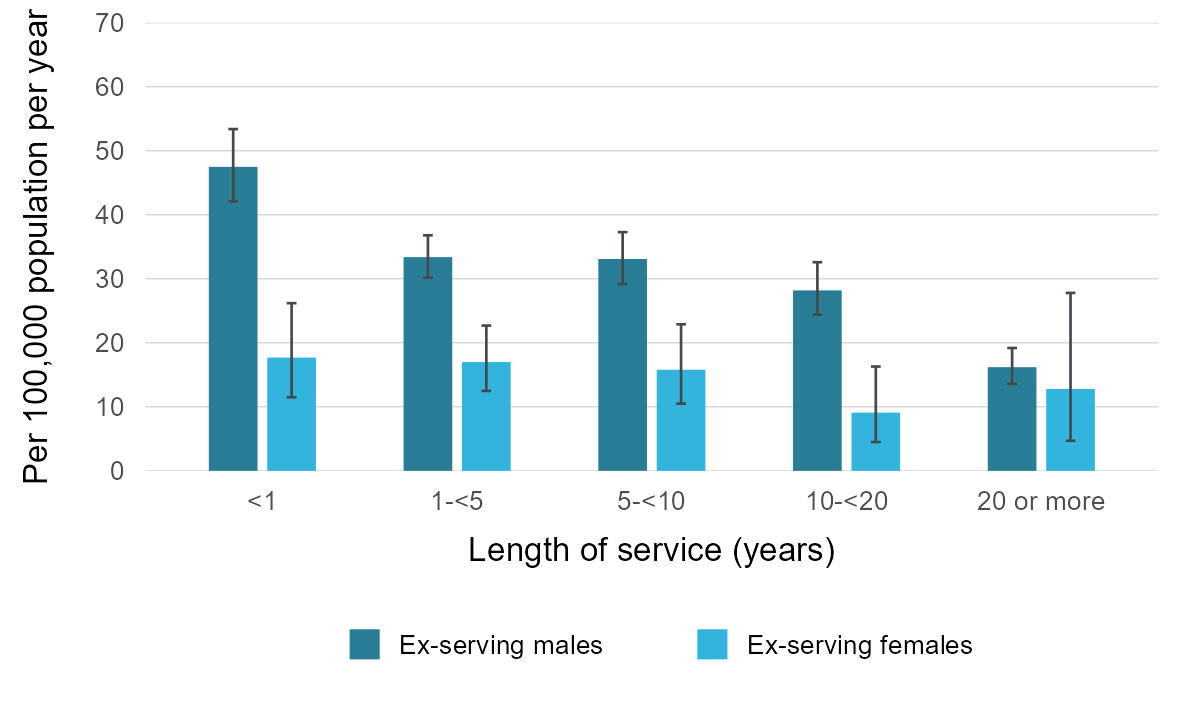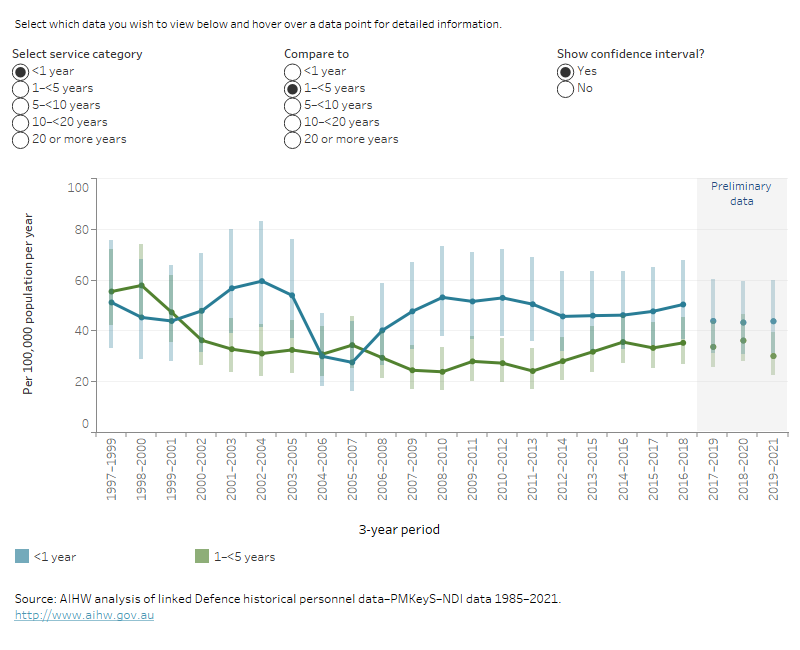Length of service
Suicide rates by length of service
Length of service describes the time between joining the ADF and separation1. For suicide rates analysis in this report, length of service is presented in 5 groups (ranging from less than 1 year to more than 20 years).
The proportions of ex-serving males and females by varying length of service were as follows:
- 13% of males and 17% of females had served less than 1 year.
- 26% of males and 32% of females had between 1–<5 years of service.
- 18% of males and 21% of females had between 5–<10 years of service.
- 20% of males and 20% of females had between 10–<20 years of service.
- 23% of males and 10% of females had served 20 or more years.
The average length of service was higher for males than females (11 years and 8.0 years respectively).
Suicide rates for ex-serving males decreased as length of service increased. The suicide rate was lowest for males who served more than 20 years (16.2 per 100,000 population per year) and highest for those who had served less than one year (47.5 per 100,000 population per year). These are significantly different from the 1–<5, 5–<10 and 10–<20 year categories, which are themselves statistically similar, as shown in Figure 11 below.
For ex-serving females, rates of suicide were statistically similar for all lengths of service. This is shown in Table 8 and Figure 11 below.
Length of service (years)(a) | Ex-serving males: Suicide rate per 100,000 population per year | Ex-serving females: Suicide rate per 100,000 population per year |
|---|---|---|
<1 | 47.5 | 17.7 |
1–<5 | 33.4 | 17.0 |
5–<10 | 33.1 | 15.8 |
10–<20 | 28.2 | 9.1* |
20 or more | 16.2 | 12.8* |
Notes:
* Suicide rates in this Table denoted with a '*' should be interpreted with caution as the number of suicides is fewer than 20. These rates are considered potentially volatile.
a. The time between the date of hire and date of separation from the ADF.
Source: AIHW analysis of linked Defence historical personnel data–PMKeyS–NDI data 1985–2021.
Figure 11: Suicide rate by length of service, ex-serving males and females, 1997–2021

Source: AIHW analysis of linked Defence historical personnel data–PMKeyS–NDI data 1985–2021.
Suicide rates by length of service over time
The suicide rates for ex-serving males by the 5 length of service groups were relatively stable over time. There appears to be a large decrease over the years 2004 to 2007 among the <1 year cohort, though this fluctuation is not statistically significant relative to other datapoints in this series.
Due to the small number of suicide deaths among ex-serving females, suicide rates by length of service over time are not reported.
The interactive graph below (Figure 12) presents the suicide rates for ex-serving males in each of the length of service groups, for all 3-year periods from 1997–1999 to 2019–2021.
Figure 12: Rate of suicide for ex-serving males by length of service, 1997–1999 to 2019–2021
This time series line graph shows the weighted average suicide rate per 100,000 population per year of ex-serving males by length of service over time by 3-year periods from 1997 to 1999, to 2019 to 2021.

Notes:
* Suicide rates in this Figure denoted with a '*' should be interpreted with caution as the number of suicides is fewer than 20. These rates are considered potentially volatile.
The confidence intervals in this Figure can be used to determine whether there is a statistically significant difference between the suicide rates calculated for the ADF between different 3-year periods. However, they cannot be used to determine whether there is a statistically significant difference between rates calculated for the ADF population for overlapping 3-year time periods (for example 2002–2004 and 2003–2005).
Data underlying this graph are available in Supplementary table S6.6. See Data for a link to the tables.
Please note, data for more recent years are subject to change; see the Technical notes for further detail.
Help or support
If you need help or support, please contact:
- Open Arms – Veterans and Families Counselling – Phone: 1800 011 046
- Open Arms Suicide Intervention
- Defence All-hours Support Line (ASL) – Phone: 1800 628 036
- Defence Member and Family Helpline – Phone: 1800 624 608
- Defence Chaplaincy Support
- ADF Mental Health Services
- Lifeline – Phone: 13 11 14
- Suicide Call Back Service – Phone: 1300 659 467
- Beyond Blue Support Service – Phone: 1300 22 4636
For information on support provided by DVA, see:
- Recall that the separation point used in this study reflects full separation from the ADF – that is, when a member is no longer permanent or reserve. For example, a member who transfers from full time service to the reserves is not yet counted as having separated.


